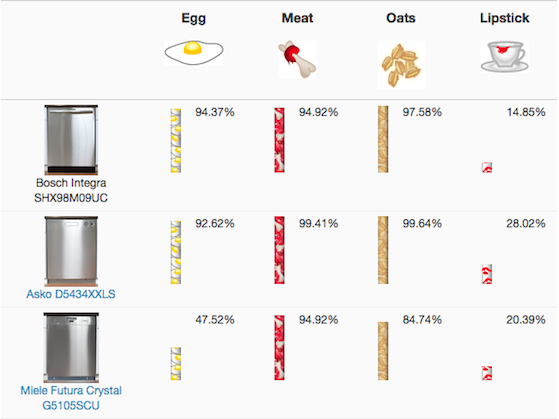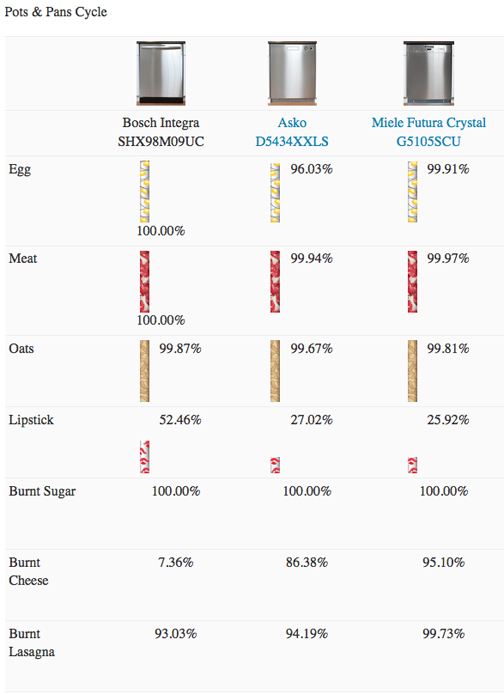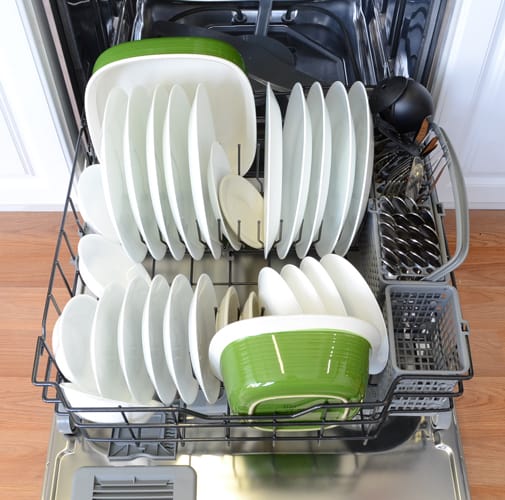Introduction
Front
{{section_header}}{{section.name}}{{/section_header}}
The front of the machine features a linear door handle and a control display. The screen cannot be operated directly, but it displays information such as cycle selection and duration.

The front of the GE CDWT980VSS.
Finish
{{section_header}}{{section.name}}{{/section_header}}
The stainless steel finish seemed to attract a lot of fingerprints—more so than usual. This isn’t a deal-breaker, of course, but it can be frustrating.

Controls
{{section_header}}{{section.name}}{{/section_header}}
The control interface is the {{product.model}}’s double-edged sword. It’s helpful for customizing unique wash cycles with specific efficiency, drying, and intensity settings. As nifty as it is, though, we found ourselves wishing the whole thing was just button-operated. Other folks may disagree, however.


Interior
{{section_header}}{{section.name}}{{/section_header}}
The wash tub is also stainless steel, which makes for an extremely quiet wash—not to mention a more thorough drying stage.

The CDWT980VSS with door open.
Top Rack
{{section_header}}{{section.name}}{{/section_header}}
Both racks are sturdily built and adjustable. While we would have liked some of the tines in the top rack to have been closer together, it didn’t blight the machine’s strong capacity score (11 place settings).

The top rack of the CDWT980VSS.
Bottom Rack
{{section_header}}{{section.name}}{{/section_header}}
The bottom rack features six rows of tines. We found that their angle made for a challenging process loading bulky dishware, such as pots and pans. Even so, we were able to fit a lot of items.

The bottom rack of the CDWT980VSS.
Cutlery Basket
{{section_header}}{{section.name}}{{/section_header}}
The cutlery basket is not the most elegantly designed component, but it serves its purpose, and the foldable lids allow for flexibility when loading silverware and utensils.

The CDWT980VSS cutlery basket.
Electricity Use
{{section_header}}{{section.name}}{{/section_header}}
The {{product.model}} used a normal amount of energy on the quick and heavy washes (called “Party Wash” and “Super Auto Wash,” respectively), and far less on the normal cycle (“Auto Wash”). Specifically, the Auto Wash used a mere 0.37 kWh, which makes for an electricity cost of about 4 cents per wash. The Party and Super washes, on the other hand, consumed 0.39 and 0.78 kWh, respectively.
Water Use
{{section_header}}{{section.name}}{{/section_header}}
Once again, it was the Auto Wash that proved the most efficient, to the point that it contributed the bulk of the {{product.model}}’s high efficiency score. It used a mere 1.83 gallons of hot water per cycle, which makes for a water cost of about 2 cents per wash. The Party and Super cycles, however, used up 3.29 and 5.74 gallons, respectively. This makes for an average water cost of 2 to 3 cents per cycle—on par with market standards.
Yearly Running Cost
{{section_header}}{{section.name}}{{/section_header}}
If it weren’t for the ridiculously efficient Auto Wash, the {{product.model}} would pass with average efficiency scores. But because that cycle uses so little water (and electricity), it brought the whole yearly operating cost of the machine down to a whopping $19.46. That’s based on the assumption that the Auto Wash will be used fifty percent of the time over the course of a year (which makes for an individual wash cost of only 6 cents!).
{{comparison_bars title="Yearly Running Cost", attribute="Yearly Running Cost", xLabel="Cost to run over a typical year ($)"}}
Washing Speed
{{section_header}}{{section.name}}{{/section_header}}
The Party Wash finished in a whopping half-hour. While this cycle is intended for lightly soiled dishes, we imagine it’d be very helpful for a mid-party rinse. Hence the name. The Auto Wash and Super Auto Wash took 88 and 93 minutes to finish, respectively.
Washing Performance
{{section_header}}{{section.name}}{{/section_header}}
Like so many other things with this dishwasher, the wash performance was a bit temperamental. The Super Auto Wash probably ranks among the best heavy cycles we’ve tested, helping to improve the machine’s overall performance score. But the Party and Auto Washes were average or worse. This once again raises the question of price and whether the $1,600 price tag is justified.

Quick Wash Cycle
{{section_header}}{{section.name}}{{/section_header}}
The Party Wash had some trouble with protein stains, particularly our egg, milk, and meat tests. It did better with tea and oatmeal, but we still wouldn’t recommend using it for regular dish loads.

Normal Wash Cycle
{{section_header}}{{section.name}}{{/section_header}}
The Auto Wash, aside from being extremely efficient, showed decent performance. For any dishwasher under $1,000 we’d be impressed, but at $1,600 we were a bit dismayed. It didn’t perform poorly, but for a high-end machine it was pretty mediocre. We expected better.
Normal Cycle

Heavy/Pots & Pans Wash Cycle
{{section_header}}{{section.name}}{{/section_header}}
By far the best performing cycle. The Super Auto Wash consumed more water and electricity but not enough to discourage frequent use. It also had perfect or near perfect scores on many of our tests. It even did well on our lipstick stain, which is rare. We would recommend using this cycle often.
Pots & Pans Cycle

Washing Cycles
{{section_header}}{{section.name}}{{/section_header}}
There are four main cycles, all of which can be modified or customized. They include Party Wash (quick cycle), Auto Wash, Super Auto Wash, and Auto Delicate Wash.

Customization
{{section_header}}{{section.name}}{{/section_header}}
Each wash option and customization feature can be added to one of the above cycles.

Additional Wash Options
{{section_header}}{{section.name}}{{/section_header}}
The wash options and customization features are essentially one and the same. They include: a delay (up to 24 hours), three drying programs (Economy, Normal, and Extra), an Eco function, and four wash programs (Regular, Enviro Care, Glass Care, and Extreme Wash).

Capacity
{{section_header}}{{section.name}}{{/section_header}}
We were able to fit 11 place settings and one serving setting. This is impressive and above average for the market.

Top Rack

Bottom Rack

Wash Arms & Filters
{{section_header}}{{section.name}}{{/section_header}}
The wash arms are a bit flimsy and feel surprisingly cheap for such an expensive machine. This may have contributed to the so-so performance of the Party and Auto Washes, but the curved design surely helps spread water and maximize rinse exposure.
The filter includes three detachable units—a main filtration cylinder, an exterior fine grain filter, and a wash tub filter plate. The whole unit is easy to remove and clean.

The CDWT980VSS wash arms.

The DW 14140 upper wash arm

The CDWT980VSS filter.
Lower Dish Rack
{{section_header}}{{section.name}}{{/section_header}}
The lower dish rack includes four collapsible rows of tines. While we never felt the need to fold them, we imagine they would come in handy when loading large or awkwardly shaped items, although they did seem to collapse a bit too easily.

The bottom rack of the CDWT980VSS.
Upper Dish Rack
{{section_header}}{{section.name}}{{/section_header}}
Like the bottom rack, the top rack features four rows of foldable tines. We had little trouble fitting large loads in the upper rack, as the adjustability made for a pretty intuitive and straightforward experience.

The top rack of the CDWT980VSS.
Cutlery Holder
{{section_header}}{{section.name}}{{/section_header}}
The cutlery holder is pretty standard—nothing to write home about. It’s adjustable, spacious, and easy to use.

The CDWT980VSS cutlery basket.
Detergent Dispenser
{{section_header}}{{section.name}}{{/section_header}}
The detergent dispenser features two lines for measuring detergent volumes. It also has a standard rinse aid container.

The CDWT980VSS detergent dispenser.
Ease of Use
{{section_header}}{{section.name}}{{/section_header}}
The {{product.model}} is pretty easy to use, and we don’t imagine anyone who’s ever used a dishwasher before—even once—will have trouble. Our main beef was with the electronic control panel, which seemed to involve an unnecessary or overly complex amount of work to operate.
Noise
{{section_header}}{{section.name}}{{/section_header}}
The {{product.model}} is very quiet thanks to the stainless steel interior. The relatively small amount of water that this machine uses also limits its noisiness. We don’t imagine anyone will have complaints about volume.
Controls
{{section_header}}{{section.name}}{{/section_header}}
The electronic control panel is cool—one of the niftiest we’ve come across—but it’s not exactly practical. To scroll through the options you have to hold your finger above a button (all of which are touch-sensitive) for what seems like a long time. Also, menu items don’t repeat, so if you’re at the end of the list of wash cycles, for example, and you want to go back to the beginning, you have to scroll all the way to the left instead of letting the list repeat itself. It’s also a bit difficult to choose customization options as some are buried within other settings, which you have to find by scrolling through the menu options. Honestly, as cool as the interface is—including the display on the front that shows cycle data—we would have preferred a standard button arrangement.


Efficiency
{{section_header}}{{section.name}}{{/section_header}}
Once of the most efficient dishwashers we’ve ever tested, the {{product.model}} will cost you less $20 a year to operate. Our calculations, which are based on the assumption that the Normal Cycle (Auto Wash) will be used 50 percent of the time, show a yearly operating cost of $19.46. This is extremely low, mainly because of the Auto Wash, which used a mere 1.83 gallons of hot water and 0.37 kWh per cycle.
Washing Performance
{{section_header}}{{section.name}}{{/section_header}}
The cleaning power of the {{product.model}} varies from cycle to cycle. Because the machine is so efficient, we’d recommend using the Super Auto Wash most often. It lasts only about 5 minutes longer than the Auto Wash and boasts a far superior clean across virtually all stain categories. It did particularly well on proteins and hard, baked-on food soil.
Features
{{section_header}}{{section.name}}{{/section_header}}
The {{product.model}} features a wide range of wash options and customization settings, but they’re all engaged through a rather muddled and clunky interface. Don’t get us wrong, we liked the two LCDs—especially the front display, which includes cycle information—but they seemed to be more show than substance. The features are high-end, but they don’t quite make up for the uneven wash performance.
Meet the tester
Tyler Wells Lynch is a freelance writer and journalist whose work has appeared in Vice, Wirecutter, Gizmodo, The Rumpus, Yes!, and the Huffington Post, among others. He lives in Maine.
Checking our work.
Our team is here to help you buy the best stuff and love what you own. Our writers, editors, and experts obsess over the products we cover to make sure you're confident and satisfied. Have a different opinion about something we recommend? Email us and we'll compare notes.
Shoot us an email


